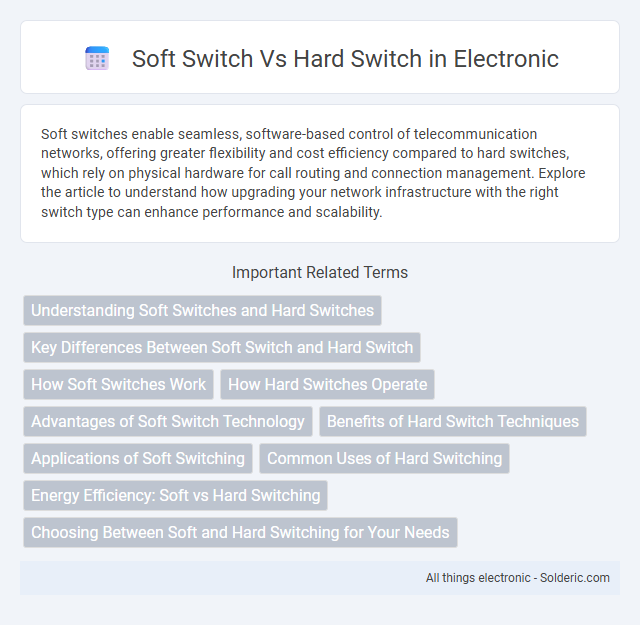Soft switches enable seamless, software-based control of telecommunication networks, offering greater flexibility and cost efficiency compared to hard switches, which rely on physical hardware for call routing and connection management. Explore the article to understand how upgrading your network infrastructure with the right switch type can enhance performance and scalability.
Comparison Table
| Feature | Soft Switch | Hard Switch |
|---|---|---|
| Definition | Software-based call control for VoIP networks | Physical hardware device for circuit switching |
| Technology | Runs on general-purpose servers | Uses dedicated hardware components |
| Flexibility | Highly programmable and scalable | Limited to fixed functionalities |
| Cost | Lower initial investment, cost-effective | Higher upfront cost due to hardware |
| Deployment | Faster deployment with software updates | Longer deployment cycles |
| Maintenance | Easier updates and management | Requires physical servicing |
| Scalability | Easy horizontal scaling | Scaling needs additional hardware |
| Use Case | VoIP providers, cloud-based services | Traditional PSTN networks, legacy systems |
Understanding Soft Switches and Hard Switches
Soft switches utilize software-based controls to manage voice and data traffic within telecommunications networks, offering flexibility and scalability. Hard switches rely on hardware components to perform switching functions, ensuring high reliability and low latency suitable for traditional circuit-switched networks. Understanding the distinction highlights soft switches' adaptability in IP-based environments versus hard switches' robustness in dedicated physical infrastructures.
Key Differences Between Soft Switch and Hard Switch
Soft switches manage voice calls using software-based control on IP networks, enabling flexible call routing and integration with advanced features like VoIP. Hard switches rely on physical hardware circuits to establish connections, offering low latency and high reliability for traditional telephony systems. Understanding these key differences helps you choose the right solution for your communication infrastructure needs.
How Soft Switches Work
Soft switches operate by managing voice traffic through software on central servers that control call setup, routing, and termination, replacing traditional hardware-based circuit switching. They utilize protocols like SIP (Session Initiation Protocol) to enable flexible and scalable voice over IP (VoIP) communication across different networks. This software-driven approach allows seamless integration with various telephony systems and supports advanced features such as call forwarding, voicemail, and conferencing.
How Hard Switches Operate
Hard switches physically interrupt the electrical circuit to stop or change the flow of current, providing reliable and instantaneous switching. These devices use mechanical components like contacts or relays that open or close the circuit, ensuring a clear distinction between on and off states. Your system's performance depends on the durability and responsiveness of the hard switch mechanism for efficient operation.
Advantages of Soft Switch Technology
Soft switch technology offers enhanced flexibility by enabling seamless control over voice and data traffic in IP-based networks. It reduces hardware dependency, leading to lower operational costs and simplified network management. Your communication infrastructure benefits from improved scalability and easier integration with advanced multimedia services.
Benefits of Hard Switch Techniques
Hard switch techniques offer low latency and high reliability, making them ideal for real-time communication systems requiring fast and deterministic response times. These techniques reduce CPU load and power consumption by directly controlling hardware states without complex software intervention. Your network benefits from robust performance and minimized jitter, ensuring consistent call quality and seamless data transmission.
Applications of Soft Switching
Soft switching technology is extensively applied in power electronics to enhance the efficiency and reliability of inverters and converters used in renewable energy systems, electric vehicles, and telecommunications. Its ability to reduce switching losses and electromagnetic interference makes it ideal for high-frequency applications such as LED lighting and induction heating. Soft switching enables longer device lifespan and improved thermal management in advanced power supplies and motor drives.
Common Uses of Hard Switching
Hard switching is commonly used in power electronics for controlling high-voltage and high-current loads, such as in motor drives, power supplies, and lighting systems. Its straightforward design enables rapid switching transitions, making it suitable for applications requiring robust and cost-effective solutions. Despite higher switching losses and electromagnetic interference, hard switching remains prevalent in industrial and consumer devices due to its simplicity and reliability.
Energy Efficiency: Soft vs Hard Switching
Soft switching significantly improves energy efficiency by reducing switching losses through techniques like zero-voltage or zero-current switching, minimizing heat generation and enhancing system reliability. Hard switching causes higher energy dissipation due to abrupt transitions in voltage and current, resulting in increased power loss and thermal stress on components. Choosing soft switching for your power electronics can lead to better performance and lower energy consumption in high-frequency applications.
Choosing Between Soft and Hard Switching for Your Needs
Soft switching reduces electromagnetic interference and switching losses by using controlled transitions, making it ideal for high-frequency and energy-efficient applications. Hard switching involves abrupt transitions with higher switching losses and noise but offers simplicity and lower component costs for less demanding environments. Select soft switching for improved efficiency and reliability in sensitive or advanced systems, while hard switching suits cost-sensitive, straightforward designs.
Soft switch vs Hard switch Infographic

 solderic.com
solderic.com